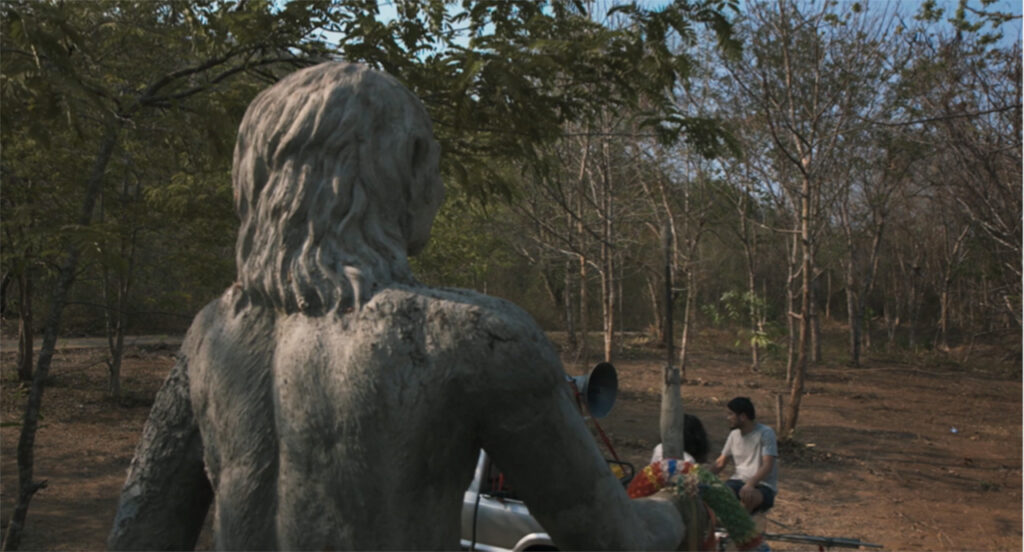Spirituality and the Power of Cinema
Chai Siris’ 500 000 Years has the ability to both scare and fascinate. Beginning with the feel of a documentary, this short film gradually pushes us from reality into the supernatural as we witness the carrying out of an outdoor film screening. As the credits finished rolling and the screen faded to black, I found in my mind a jumble of words: death, spirituality, illusion, cinema. I was impressed by the complexity of ideas presented in his film, but what I wanted to do most was to make sense of what I had just experienced. In this process I found myself an answer: 500 000 Years was, above all, a celebration of the power of cinema.
If you are, as I was, unfamiliar with Southeast Asian religious rituals, the screening of films as an offering to spiritual deities is a traditional practice in Thailand. The outdoor cinema industry, however, is gradually reaching the end of its days. The site of spiritual worship is an archaeological site where a Homo erectus fossil was unearthed several years ago but has since been abandoned. Although we can see traces of human presence through offerings left on an altar, skeletal zinc-roofed shelters and plastic bags lying on the dry grass, the place is otherwise void of human life. In these ways, 500 000 Years starts off in a state on the brink of death, at the edge of the human world.

The relationship between cinema and spirituality in this film is interesting, for although the dying out of the outdoor cinema implies that its importance to people is fading, cinema is also given transcendent qualities and spiritual power because it is seen as worthy for consumption by deities. This spiritual recognition makes cinema more powerful inspite of its waning status among mortals; for the authority of spirits seems to be much greater than the humans’. Why do I say so? Throughout the film, the worshipped Homo erectus statue exudes a dominating presence, seen through Siris’ use of camera angles.

However, cinema’s power not only lies in its transcendent status: Siris shows us how films can impose physical changes in their environment and bring it to life. The outdoor cinema operators try to screen two films in succession: one depicting an exaggeratedly upbeat urban life, and another featuring fearful people at the mercy of spiritual apparitions. When the second film comes on, we immediately start to feel how the screening atmosphere completely changes, almost as if the spiritual site has become part of the film itself. In contrast to the bare lifelessness of the abandoned archaeological site was before the screenings, the place was now brought to life by the screening of a horror film. The Homo erectus statue flickers under the projector lights, inciting fear and giving the illusion of movement. Mist also appears, rolling over projection equipment and the Homo erectus statue, as if intentionally obscuring them from our sight.
This illusionary reality is another aspect of cinematic power. Until the end of the outdoor cinema film screening scene, 500 000 Years only featured diegetic sounds (i.e. sounds whose sources are visible on-screen). We are aware of the artifice of this atmosphere, yet we allow ourselves to be immersed in it and be afraid of it. In fact, I found myself being more gripped by this illusion than by the preceding scenes that were more faithful to reality. Cinema’s power thus also lies in its ability to create lingering effects and its capability to make us willingly believe in its artifice.

I would say that Siris puts the greatest emphasis on a film’s ability to immerse us in an artificial reality. Almost two-thirds of the film’s runtime is dedicated to showing us the processes behind how film is put to screen in an outdoor setting. It is a very mundane and drawn-out process that takes away the smooth magic and beauty of conventional indoor theatre screening and forces us to focus on the tedious technicalities in outdoor cinema. Despite being drawn to an awareness of every step that precedes a film screening, it is fascinating how we are still able to be completely immersed in it. In this way, film screenings works differently from magic tricks, where knowing the steps prevents us from ever being awed by it again. 500 000 Years shows us that cinema is not magic – it has the power of something much more.
While 500 000 Years feels more like a celebration of cinema than an attempt to cling on to the dying tradition of outdoor film screening, there may be still some value in asking this question: Is the end product of an outdoor film screening truly worth the work? In a way we could say yes because as portrayed in the short film, the horror film managed to have its effects transcend the boundaries of the screen. Yet, keeping in mind the low sound and visual quality of outdoor screenings within 500 000 Years, as well as the fact that the success of our immersion comes from watching this short film in an indoor, conventional cinema-screening setting, perhaps it might be time to let go of outdoor cinema and just like the Homo erectus, let it become part of history.
Catch Chai Siris’ 500 000 Years in Programme 1 of the Southeast Asian Short Film Competition on 2nd December (Friday), 7:00pm, at the National Gallery Auditorium. BUY TICKETS


